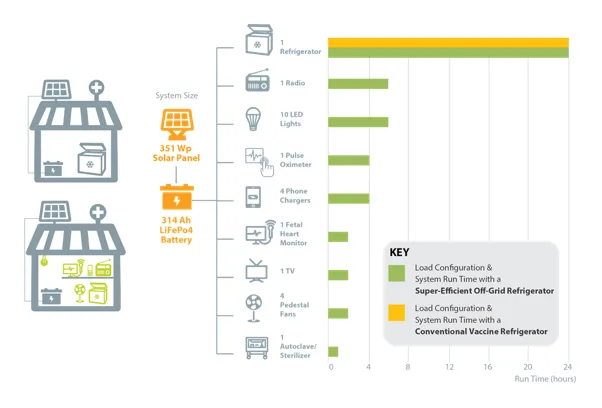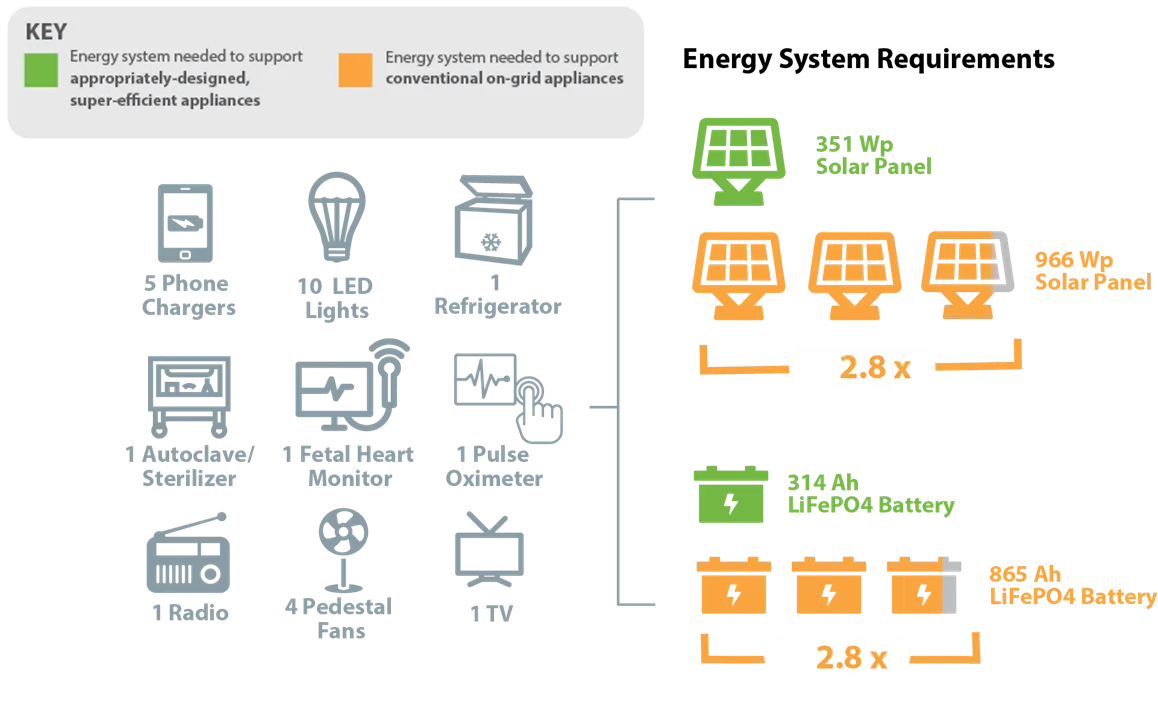Is Energy Efficiency the Missing Link in Health Access?
Without electricity, clinics cannot utilise some of the most basic tools required to provide modern medical care. The implications for health outcomes — particularly for women and children — are enormous

By Jeff Stottlemyer, Senior Manager at CLASP, Co-Secretariat to the Efficiency for Access Coalition
The World Bank and World Health Organisation (WHO) estimate that only 28–34% of health facilities across sub-Saharan Africa have access to reliable electricity. Without electricity, clinics cannot utilise some of the most basic tools required to provide modern medical care. The implications for health outcomes — particularly for women and children — are enormous. Stories of women giving birth by candlelight or next to kerosene lamps are all too common. According to the WHO, 295,000 women died during childbirth in 2017–196,000 of these deaths are in sub-Saharan Africa. Expanding modern energy and health services are essential to increasing the quality and availability of care for women and improving the overall quality of life in off- and weak-grid communities.
The importance of the energy/health nexus is now widely recognised by the development and donor communities. Unfortunately, funding and capacity gaps restrict the focus of most on-the-ground electrification efforts to the provision of distributed renewable energy systems that make electricity available, while often ignoring the devices that turn electricity into health services: appliances. Large-scale procurements associated with health ministries and donor-funded clinic electrification efforts often leave out basic appliances and medical devices such as fetal heart monitors, oxygen concentrators, sterilisers, and refrigerators altogether. However, providing energy systems for clinics without considering which devices they will power often results in under-utilised, over-sized, and unnecessarily expensive energy systems. Medical staff often must rely on charities or separate donor-funded initiatives to access an ad hoc set of appliances and devices of unknown quality — if they can get them at all.
Super-Efficient Appliances Enable Cost-Effective, Holistic Clinic Electrification
Despite their absence from many clinic electrification efforts, appropriately designed, highly energy-efficient appliances and medical devices designed for use with off-grid solar energy systems can dramatically expand health service provision at off-grid clinics while also reducing the cost of clinic electrification overall.
How is this possible? Solar panels and batteries are the biggest drivers of the overall cost for distributed solar energy systems. Super-efficient appliances deliver the same services as conventional appliances while using significantly less energy and therefore require smaller — and cheaper — energy systems. In addition, super-efficient appliances enable an off-grid clinic to do far more with a given energy supply, expanding service delivery without requiring additional solar panels or battery capacity. Since many clinic electrification efforts provide relatively large systems as a baseline, the potential benefits here are substantial. Recent analysis by Efficiency for Access and the Clinton Health Access Initiative demonstrates the scale of the opportunity.
Let’s start with system size and cost, where the easiest way to demonstrate potential savings is by looking at one of the most impactful but energy-intensive appliances required in a clinical setting: a refrigerator. The graphic below shows that a super-efficient, off-grid appropriate refrigerator requires just 10% of the solar panel and battery capacity as a conventional solar vaccine refrigerator. That means that a clinic could pay up to 90% less for the energy system required to provide vital cold storage services.

The same super-efficient refrigerator also demonstrates the potential to dramatically expand health service delivery with a given energy system. Let’s assume that a clinic received a solar energy system designed to power the conventional, inefficient vaccine refrigerator shown above. If the clinic switched to the super-efficient model, the same energy system could power eight additional appliances, including critical devices like a pulse oximeter, fetal heart monitor, and steriliser, as shown below.

Appliance efficiency also helps ensure that a wide array of health services is available at the least cost. Inefficient models of key medical appliances require almost three times the amount of solar panel and battery capacity compared to super-efficient models, as demonstrated in the graphic below. Energy efficiency should, therefore, be a central design principle when designing health system-wide clinic electrification efforts, given the cost reduction potential at scale.

Major Gaps in Data and Market Intelligence Remain
Unfortunately, commercial markets for energy-efficient medical equipment designed to work with solar energy systems are almost non-existent. Significant technical advancements over the past 10–20 years have improved medical cold chains in off-grid areas, driven largely by WHO’s quality and certification process for off-grid vaccine refrigerators. Pioneering efforts like the collaboration between SELCO Foundation and GE Healthcare to develop modular, highly energy-efficient labor and delivery rooms as well as SELCO’s efforts to raise awareness of the need for medical device innovation more broadly have helped draw attention to the opportunity. Beyond these early movers, we’ve made little progress in building robust supply chains for off-grid appropriate versions of most core medical devices. As one medical device manufacturer said, energy efficiency, “hasn’t been identified as a key constraint for health outcomes until recently…It hasn’t been our organisational focus and clinicians aren’t focused on this either.”
Reliable data on energy consumption for currently available versions of the most common medical devices is also hard to find, and — unlike household or commercial appliances — this information is frequently missing on product specification sheets provided by manufacturers. According to one off-grid solar company that has worked on clinic electrification, “in our experience medical device distributors rarely know or market power consumption…we consistently found typos on manufacturers’ datasheets with power consumption and few devices stated their power consumption.”
In addition, little data exists on clinic-level daily energy demand or usage patterns for off-grid clinics in general, and even less data exists for clinics equipped with a full suite of appliances. Without a reliable baseline understanding of how much energy common medical devices need to run, or how those devices perform in field settings, it is difficult to direct donor funding and private investment toward efforts intended to improve product design, energy efficiency, and performance.
Collaboration and Investment Can Unlock the Potential for Improved Health Outcomes
The rapid growth of commercial markets for residential off-grid solar energy systems that power super-efficient appliances proves that energy efficiency can minimize the cost of delivering modern energy services in resource-constrained, off-grid communities. In order to realise this potential in the health sector, continued collaboration between international institutions, national government ministries, industry, and health & energy sector NGOs should focus on the following:
- Build the evidence base for efficiency: Field research on clinic-level energy and medical device utilisation will deepen our understanding of both appliance needs and usage patterns, and allow for the development an “ideal” off-grid clinic energy profile that can serve as a model for system design. We also need additional research on the efficiency and performance of conventional medical devices to identify opportunities for design improvements and efficiency gains.
- Engage medical device and appliance designers & suppliers: Industry outreach focused on raising awareness of the unique operating constraints in off-grid clinical settings along with programs that incentivise the development of off-grid appropriate, super-efficient versions of common medical devices will help kick-start supply chains.
- Incorporate appliances into clinic electrification delivery models: National clinic electrification programs provide detailed specifications for energy system design and components to guide companies, civil society organisations, and technicians that install and maintain these systems. However, electrification programs often include only indicative guidance on the types of appliances certain types of clinics may need. Appliances should be included as a core element of system design and associated technical specifications, and all systems should be installed with a suite of quality-assured, super-efficient, off-grid appropriate appliances.
- Include energy efficiency in the criteria for existing appliance procurement programs and certification requirements: WHO and national equipment specification/certification requirements for medical appliances such as refrigerators still often leave out efficiency. Including efficiency targets or requirements in procurement calls and equipment guidelines has the potential to move markets by sending a powerful signal to appliance and device suppliers.
These efforts will require an increase in donor investment and alignment of donor priorities. Efficiency for Access is committed to both facilitating that alignment and directly supporting programs that drive greater health outcomes for the world’s poorest communities and alleviate the disproportionate health inequities felt by women and children. Our #Appliances Empower communications campaign spotlights a variety of innovative approaches to improving the quality of life for women through access to modern energy. Our December 11 Twitter chat will discuss the energy-health nexus as it relates to SDG 5: gender equality — be sure to follow #AppliancesEmpowerChat from 9:30–10:15 am EST. In 2020, we plan to kick off a new suite of activities that will start to unlock the potential for energy efficiency to improve health outcomes in off-grid areas around the world. Stay in touch to learn more.